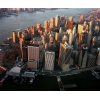|
 Not so long
ago there was a great boom for the elite real estate in New York. When prices for
real estate eased till incredible level throughout America, the same was
persistently climbing up for apartments in Manhattan. In 2007 prices for housing
in Detroit were even lower than prices for cars; the cost of flats there was
compared with the price of a good thoroughbred cow, while an apartment in
Manhattan averaged USD 1,37 million and it was still growing. Not so long
ago there was a great boom for the elite real estate in New York. When prices for
real estate eased till incredible level throughout America, the same was
persistently climbing up for apartments in Manhattan. In 2007 prices for housing
in Detroit were even lower than prices for cars; the cost of flats there was
compared with the price of a good thoroughbred cow, while an apartment in
Manhattan averaged USD 1,37 million and it was still growing.
In 2008 prices
for Manhattan apartments increased for 41%, yet the median price turned USD 1 million.
Such situation
looks peculiar and paradoxical only at a first glance. The point is Manhattan apartments
were purchased by people other than Americans. Elite real estate drew attention
of foreign investors. As soon as dollar went falling and there occurred an
interesting exchanges difference against Euro and GBP. Due to such exchange difference
the cost of Manhattan housing decreased as compared with the same housing in
London and other capital of the world (for instance, real estate value in Paris
had 100% rise that time, and in Manhattan it was falling, and considering the exchange
difference, the price increased in USD value only. Besides, developers afraid of
slowdown and drop of currency initiated offering significant discounts (15-20%)
that made investments to Manhattan real estate more attractive.
The interest
of foreign buyers of Manhattan flats totaled almost 50% in 2008, while in 2007 it
was 10%, not more. And foreign investors were greatly concerned about elite
apartments. The average price for an apartment with three to four bedrooms in
the upper eastern part of Manhattan (the most privileged part of Manhattan)
reached 6-7million dollars (breakthrough made 17%), while the same apartment in
the less privileged part of Manhattan cost approximately USD 4,6 million (breakthrough
made about 46%).
Invasion of
foreign purchaser towards the American real estate facilitated some experts to
make timid proposals that investors from abroad will help the country to
overcome with the crisis. A strong demand for Manhattan apartments specially inspired
by the same strong price increase in the latter. Other experts found the situation
oppressive when foreign investors support the market of housing in America.
Yet, the situation
remained stable for Manhattan even during the crisis peak (in September
previous year). Banks were breaking down, people were dismissed in mass, and 91
elite apartments were sold in the housing complex Cipriani Club Residences that
is located in the Financial District (round the Wall Street which residents are
those who live on this street), and in total there 106 luxury apartments in
this complex. While employees of banks out of business were tearing their hair,
the penthouse in the Setai - in the same Financial District - was successfully
sold for USD 7,82 million.
The better
part of apartments in Manhattan was sold as investments with the purpose of
further lease. Thus, approximately 90% of apartments in Pine complex (Financial
District, de luxe apartments).
Currently, when
dollar takes its positions back, the Manhattan apartments became less popular.
Yet, experts predict that flourishing at the market of Manhattan real estate will
come to end along with appreciation of dollar, since this flourishing is
conditioned by foreign investments, while exchange rate difference will become
far less. Besides, ‘foretellers' in the market of real estate predict high dismissal of Wall-Street employees,
especially of such a ‘payroll category' who can afford such a luxury apartment
in the most fashionable district of New York close to work place.
Though developers
appear to mistrust the dollar convertibility and still go on offering discount pricing
for Manhattan apartments. Their mission is to sell the real estate available within
the nearest half a year, while the average sales term now makes about eight months
(against four months in the latest period), and the experts assure that this term
will be extended (particularly, Mark Harvey, Head of Investigation Department
in the sphere if international projects of the Agency on the sale of elite real
estate, is of the same opinion) who
thinks that «new projects in expensive regions may face deficit of demand and
time».
Growth in dollar
brought to the shift in priorities of foreign investors. Currently they are more
interested in reliability of houses and good neighbors rather than in elite
apartments in Manhattan. The Times suggests that ‘foreign investors pay their attention
to Lower East Side as the region quite cheap to attract students, ex-hippies
and those for whom this is the first housing'. From all opinions, the demand
for elite apartments in Manhattan will decrease, and thus prices will get
lower. Though, if dollar scrawls down again, the situation may change.
|